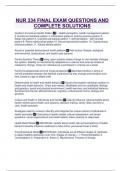NUR 334 FINAL EXAM QUESTIONS AND
COMPLETE SOLUTIONS
Gordon's Functional Health Pattern✅1. Health perception- health management pattern
2. Nutritional-metabolic pattern 3. Elimination pattern4. Activity-exercise pattern 5.
Sleep-rest pattern 6. Cognitive-perceptual pattern 7. Self-perception - self-concept
pattern 8. Roles-relationships pattern 9. Sexual-reproductive pattern 10. Coping-stress
tolerance pattern 11. Values-beliefs pattern
Actual or potential dysfunctional health patterns✅Risk factors: lifestyle, biological,
environmental, sociocultural, and health care systems
Family Systems Theory✅living, open systems where change in one member changes
the system. Stability is maintained by adaptations to internal and external stressors
created by change. Views an individual as a participant in a family as a whole
Family Developmental and Life Cycle perspective✅describes families in terms of
normal predicted stresses that families experience as they change and transition over
time, based on age of eldest child
Determinants of health and health behavior✅Factors that explain individual variation in
health and health behavior. Direct and indirect. Modifiable and non-modifiable. Biology
and genetics, social and physical environment, health services, and individual behavior.
Social/environmental, affect/emotional, cognitive, culture/social norms, biology and
genetics
Culture and health in individuals and families✅Cultural influence: general beliefs about
health, beliefs about health care systems, decision making, family roles, barriers to
care, health practices
Strategies used by nurses to identify and integrate the unique culture of individuals in
health promotion✅Conducting a health-related cultural assessment: ask broad
questions- social organizations and health beliefs, listen carefully to responses
Health Belief Model✅INDIVIDUAL; beliefs about health risk and perceptions of health
behavior benefits influence readiness to take action, perceived threat is direct
Transtheoretical Model✅INDIVIDUAL; individuals are at different stages of readiness
to adopt healthful behaviors over time. Stages of change = 1. Precontemplation 2.
Contemplation 3. Preparation 4. Action 5. Maintenance. Process of change.
, Social cognitive theory✅INTERPERSONAL; people learn not only from their own
behavior but observing the actions of others and the results of those actions
Describe how health promotion and risk reduction theories are used in nursing
practice.✅Used to stop risky behaviors, interventions target where they are, developed
based on people who actually made behavior changes, allows for targeted interventions
Primary level of health promotion/prevention✅detection of disease in its early stages in
order to treat it an deter its progression.
Secondary level of health promotion/prevention✅reduce cost of disease management
by avoiding costly interventions required at later stages.
Tertiary level of health promotion/prevention✅stop progress of known disease and
disease management
Screening effectiveness✅Validity- test measures what its suppose to measure
(accuracy). Reliability- test consistently measures the same thing. Sensitivity- how often
a person with the disease with test positive. Specificity- how often a test will be negative
if the person does not have it
WHO Screening criteria✅criteria to be effective for screening tools. Important health
problem, acceptable treatment available, facilities for diagnosis, systematic stage, test
or exam, acceptable test for population, natural history of condition, agreed policy for
who can treat, reasonable cost/benefit ratio, continuing process.
Pregnancy screening✅pap smear, HIV, CBC, urine culture STI, rubella titer, ABO and
Rh typing, hepatitis B, QUAD screen (neural tube defects), Gestational diabetes, group
b strep, meningitis
Health Education✅: involves teaching and learning strategies, goal is behavior that
results in improved health status, learners maintain voluntary control over the decision
to engage in behavior or not. Learner assessment- age, developmental status, level of
education, health beliefs, motivation, readiness to learn, current knowledge and skills,
barriers and facilitators to learning. Expect learning outcomes- established jointly, health
behavior change/health status to be achieved, steps to be taken by learner, clearly
stated action goals that are measurable/defined. Cognitive: new factors or concepts,
knowledge, perceptions (values, beliefs, attitudes). Psychomotor- developing
physical/motor skills.
Brief Interventions✅designed to motivate individuals at risk of substance abuse and
related health problems to change their behavior. Not intended to treat people with
serious substance dependence, but rather to treat problematic or risky substance use.
SBIRT✅Screening Brief Intervention Referral to Treatment




